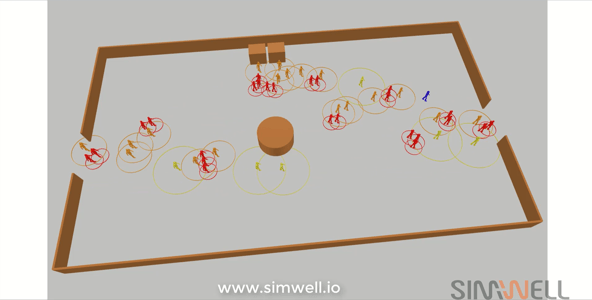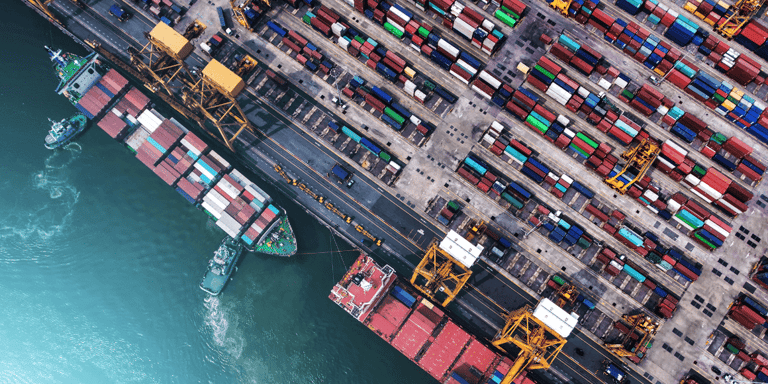
Social distancing in business operations will impact organizations for years to come.
Why? First, demand will change as customers look to lower their risk of infection.
Second, the process, people, and technology that companies base their business on will change.
And last, the KPI’s that measure success or failure will, at a minimum, shift. Most likely, new KPI’s will be established to ensure the operation successfully and profitably responds to a new norm.
But if you’re like most of us, you face uncertainty in planning for the future (more so now than ever). As a result, you follow the process that have been in place for your operation. Or you create new processes that follow health guidelines, which produce less-than-stellar results.
To improve this, we’ve created a way to include social distancing parameters in simulation models. A lot of the hard work is understanding the operation as a system and how new norms like social distancing in business operations will impact the organization. When simulation is used to model an operation as a system, we can figure out what processes, people, and technology will give us the best results…even as we move into an unknown future.
Go through this process when you are planning changes in your operation, and you’ll have the kind of information you need to maximize profit and minimize your customers risk of infection.
Creating Agents In Your AnyLogic Model That Follow Social Distancing
Why is the agent so important in this new world of social distancing?
In most business models, we focus on the process. That’s sufficient to establish a system understanding of how an operation will work. Any good simulation model will provide outputs like throughput, utilization, and costs within a few points of accuracy.
When we add in the concept of social distancing the KPI’s change. Of course, profit drivers like throughput, cost, and utilization are still key. But, we should now be aware of how our operation impacts the risk of infection for our customers.
We might be asking questions like this:
- What layout will minimize risk of infection?
- How should we direct customer flow to minimize infection?
- How should I allocate resources between check-out lines, pick-up, stocking, delivery, cleaning, etc to respond to demand?
- What changes can we make to meet service level objectives?
- What cleaning policy will minimize risk of infection while still being practical to implement?
By adding an agent into a model, it’s like adding a person into a store. We can simulate how someone moves through an operation. You can learn more about agent based simulation here. When it comes to social distancing, we can set a proximity factor to capture new KPI’s like how much time do customers spend in an “at-risk” state? How many different people does a customer come in contact with while in the business?
By simulating this information, we can test different ways to improve it. By creating agents that follow social distancing in AnyLogic models, we can make sure the business minimizes risk to customers while maximizing profit.
Business leaders that do this can lean into social distancing, and confidently promote they provide a clean, safe operation for their customers.
What Industries Will Benefit From Simulation with Social Distancing Parameters?
If a business has a flow of people, social distancing will have an impact. Here’s a few examples where agent-based modeling should be used to plan social distancing in business operations.
Airports – Airports are complex systems including retail, transportation, and a lot of queuing. Airports need to understand how to manage their systems and guide customers through the airport in a way that minimizes risk and gets them to their airplane. This is not just important for the airport to run as a business, it’s important for the airlines to succeed as they try to gain trust with flyers.
Airlines - The airline industry has been hit hard by COVID-19, but the decline in sales is just the first hurdle. Once the economy is turned on and demand for air travel increases, airlines will need to understand how to minimize the risk of infection for their customers while maintain a profit. Airlines can put their customers at high risk – so they need to consider check-in, boarding, and seating to create a safe environment.
Amusement Parks – Disney, Universal, and all of the minor amusement parks that have closed have derailed family vacations. In order to gain trust with their customers they need to plan for social distancing. Much like an airport, amusements parks are complex systems. If you consider an organization like Disney World, they have hotels, retail, transportation systems, parks, queuing, rides, etc. This creates an incredibly complex system that can be captured with agent based modeling.
Court House – COVID-19 shut down government buildings like court houses. Much like businesses, the court house has people flowing through on a regular basis. In addition, they are forced to queue for security and sit in close proximity in the court room. Government buildings will need to consider social distancing as they re-open.
Cruise Lines – The cruise line industry is another example of a complex system that includes hotel accommodations, retail, recreating, dining all driven by queuing in closed quarters. Cruise lines are further hampered by the negative press received when passengers were quarantined on ships with no option to disembark. Cruise lines need to plan their processes in world of social distancing to build trust with their customers and crew.
Grocery – Unlike some of the other industries listed here like cruise lines and airports that are hit with a loss of demand, grocery has a different challenge. Demand has increased and customer preferences have shifted. The preference has shifted from in-store shopping to pick-up or delivery. Leaders in this industry have to shift their operations to maintain a safe shopping experience while providing adequate service levels in new areas of operation.
Healthcare – Health systems have been impacted different in every region. Place like New York and Boston have seen extreme pressure on system capacity. In smaller cities and suburbs health systems have actually furloughed workers due to lack of business. Both of these systems will need to consider how they return to a new-normal while considering social distancing.
Retail – A primary KPI for retail stores is profit per square foot which tells the company how efficiently retail space is being utilized to generate a profit. For a retail environment to provide a safe, clean place for customers they will need to consider layout and customer flows in a way that will impact profit per square foot.
Stadiums – One of the most memorable stretches of news from COVID-19 was when professional and collegiate sports announced their response to the risk of COVID-19. March Madness, NBA, NHL, MLB, etc. have all been postponed or cancelled. Now these organizations are considering options to open like empty stadiums, social distancing in stadiums, operating out of open-air warm climates, and more. As organizations plan to start operation, they need to consider how to safely allow customers into their business.
Are You Planning How to Change You Operation To Support Social Distancing?
If customers flow through your physical business, you are thinking about how to open operations in a way that minimizes risk and optimizes profit.
You can use simulation to create a digital copy of your process (retail story, airport, bank, stadium, quick-service restaurants, hospital, amusement park, etc) and test different ideas to see how they impact your KPI’s like revenue, costs, utilization, throughput, service, and more.
If you need help building a model to test your ideas, we can help. Click here to start the conversation – we’d love to hear about what you are working on to support social distancing in business operations.
About Us
“For every complex problem there is an answer that is clear, simple, and wrong.” H.L. Mencken
At SimWell, we build simulation tools to help companies find the right answer to their problems. SimWell specializes in simulation, data science, and optimization.
If you need help solving a complex problem with simulation, or you need to find the right tools to do it yourself we can help. It starts with a conversation. Click here to start the conversation.






